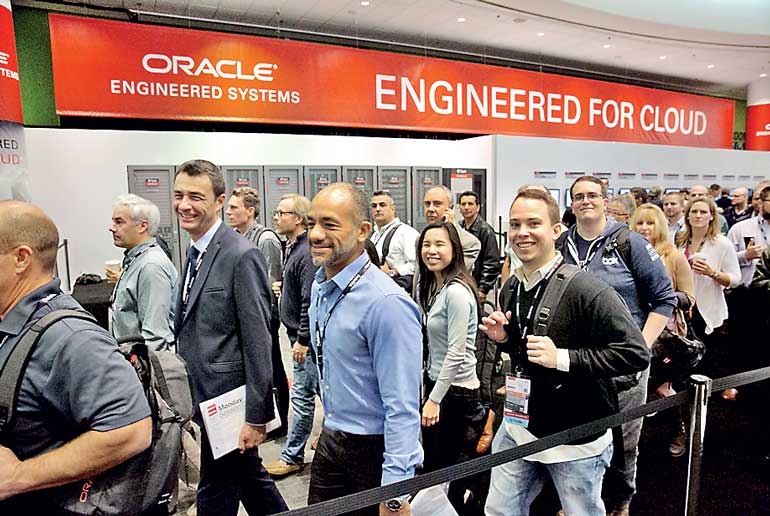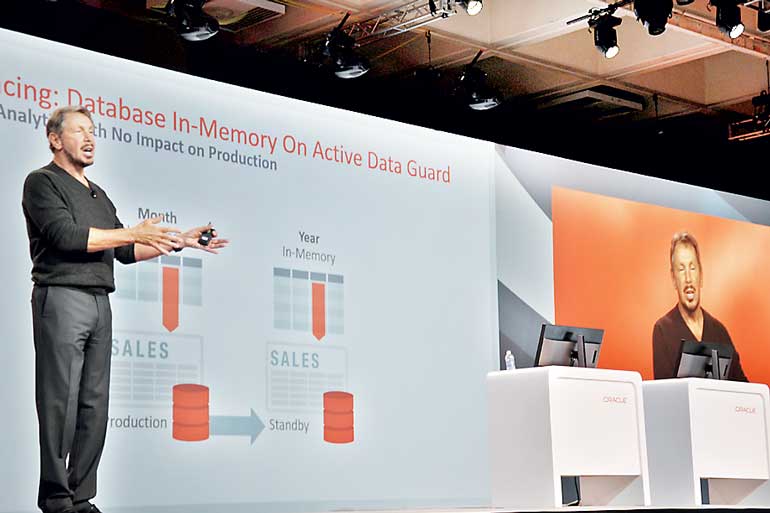Monday Jan 19, 2026
Monday Jan 19, 2026
Wednesday, 28 October 2015 00:00 - - {{hitsCtrl.values.hits}}

Some of the delegates attending the Oracle Open World 2015 which has drawn 60,000 people from over 140 countries.
 Oracle Chairman and Chief Technology Officer Larry Ellison delivers the opening day keynote at the Oracle OpenWorld 2015 in San Francisco on Sunday
Oracle Chairman and Chief Technology Officer Larry Ellison delivers the opening day keynote at the Oracle OpenWorld 2015 in San Francisco on Sunday
By Nisthar Cassim
in San Francisco
Oracle this week reinforced its leadership, unveiling eight new offerings signalling that critical digital transformation and business success in the future will be dominated by adoption of cloud computing.
Encouraged by the fact that 50% of its new business is cloud solutions and global shift towards cloud computing, Oracle said Oracle Cloud is the industry›s broadest and most integrated public cloud, offering best-in-class services across software as a service (SaaS), platform as a service (PaaS), infrastructure as a service (IaaS), and data as a service (DaaS).
Oracle Cloud helps organisations drive innovation and business transformation by increasing business agility, lowering costs, and reducing IT complexity.
The company’s push for as well as focus on cloud solutions took centrestage at the five-day Oracle OpenWorld 2015 (OOW 2015) which kicked off on Sunday in San Francisco drawing 60,000 participants from over 140 countries including Sri Lanka.
Oracle Chairman and Chief Technology Officer Larry Ellison’s much-anticipated keynote at OOW 2015 dominated the company’s success in cloud solutions, new offerings and future strategy as he spoke extensively about the new era of utility computing.
He said that cloud computing is “a generational shift in computing no less important than our shift to personal computing.” He however clarified that “on-premise” technology or IT infrastructure will not vanish but the future of business is on the cloud and seamless integration between the two – the remaining “on-premises and cloud.”
Ellison outlined Oracle’s six design goals pursued – low cost, reliability, performance, standards, compatibility and security – when developing cloud solutions to empower its customers.
“Not only will Oracle be price competitive with its cloud infrastructure services, it will help customers by automating as much of their cloud operations as possible,” Ellison said regarding the first goal. On reliability he said “There can be no single point of failure. In fact, there can’t be failures at all.”
He also said Oracle’s goal on delivering performance was to help customers to grow using few resources and the standards-based design makes it easier to adapt to cloud. He said that Oracle wasn’t merely re-labelling on-premises technology as “cloud” but every solution is freshly re-written with the Company’s Fusion middleware.
Furthermore “on-premises” technology and Oracle cloud services will be compatible.
Users should be able to “push a button” and shift workloads and data between on-premises and the cloud, even on running applications,’ noted Ellison.
At the OOW 2015, Ellison said that security goal is overarching and emphasised for him it was on top of the six goals.
“Safety and security is not an ‘on and off’ choice but an ‘always-on’ strategy to ensure continuous defence against cyber-attacks,” the Oracle Chairman stressed.
Ellison also called for a change in the current thinking on security, so as to ensure that security is designed into the IT infrastructure rather than given as an option. He said security has to be implemented lower down in the stack, starting from the hardware and not just at applications level.
Eight new services and capabilities unveiled
As proof of Oracle’s progress in cloud development, Ellison announced eight new services and capabilities:
They were 1) Manufacturing/Supply Chain Cloud Services; 2) E-Commerce as part of Oracle’s Customer Experience Cloud Services; 3) Oracle Database 12c release 2, which includes expanded multi-tenancy capabilities, among others; 4) Oracle Application Builder, a new tool that supports Oracle’s new consumer-like cloud user interface (UI); 5) Integrated Just-in-Time Learning System; 6) Oracle Exadata Cloud Service, along with Oracle Exadata In-Memory and In-Flash Database; 7) Multitenant Java Server and Fault-Tolerant Java Server and 8) Big Data Preparation, Discovery, Visualisation Cloud Services.
Ellison noted that Oracle offers all three areas of cloud services: software as a service (SaaS), platform as a service (PaaS), and infrastructure as a service (IaaS). “All three services are necessary to provide customers with a complete cloud environment that also supports their gradual move—over the next ten to twenty years,” Ellison predicted from on-premises systems to the public cloud.”
“That’s how we got to where we are today,” Ellison said adding “And where Oracle is going in the future.”
Oracle Chief said that the company was doing extremely well in SaaS and is growing faster than the competition.
Detailing Oracle’s leadership in SaaS market, especially in the high-end and mid-market cloud Enterprise Resource Planning (ERP) solutions, Ellison said the Company has 1,300 Oracle ERP customers today, 5,000 HCM (human capital management) customers and 5,000 CRM (customer relationship management) customers.
“We have extremely done well and we are growing faster than both salesforce,com and workDay,” he said referring two of the main competitors on these business segments.
Ellison also said Oracle hopes to sell $ 1.5 billion in new SaaS and PaaS business this year.
On the data base cloud service segment, despite being in the market only less than a year, Oracle has amassed 2,259 customers.
“We are excited about what we have accomplished so far,” said Ellison and suggested Oracle’s dominance will continue to grow. Overall Oracle has over 420,000 customers worldwide.
Oracle no longer pays attention to IBM, SAP
During his keynote at OOW 2015, Ellison went public about his opinion about two major competitors of Oracle when he referred to about changing market landscape of cloud services.
“Our two biggest competitors that we watched most closely over last two decades, IBM and SAP, and we no longer pay any attention to either one of them. It is quite a shock,” he claimed. “I can make the case that IBM was greatest company in the history of companies, but they are just nowhere in the cloud. SAP is the largest applications company that ever existed. They are nowhere in the cloud,” he added.
At the OOW 2015, one of the solutions offered was “Exa Your Power Program” to help customers migrate Oracle Database from IBM Power systems to Oracle Engineered Systems using Intel technology. The Company said Oracle Engineered Systems are software and hardware engineered together that provide the highest-performing and most-available platform for running Oracle Database and customer applications.
Since the launch of Oracle Exadata - purpose built to optimise the performance and cost of running Oracle- thousands of customers have moved their Oracle Databases to Oracle Engineered Systems running on Intel architecture.
The Exa Your Power program is a free database migration Proof of Concept (PoC) for qualified customers. Oracle will assess the customer’s environment, deliver a customised database migration results report, and show how they may be able to significantly reduce the time and cost required to run critical database workloads.
Ellison also commented on several of the other solutions announced at OOW 2015.
He said the new “Oracle SCM Cloud” will offer the first complete supply chain and discrete manufacturing with 100% fusion. The “E-commerce in the CX Cloud” platform will be a complete, integrated modern suite covering the customers’ requirements across the spectrum like marketing, sales, service and social responsibility.
“We are building solutions that will enable firms and employees to enjoy \better performance,” he added.
With regard to the new mobile, consumer-like Cloud UI, a state of the art mobile user interface, Ellison said “The Java-based mobile platform will always make you connected and able to work. It is a modern tablet and smartphone-friendly platform and will become the best choice among all other mobile platforms available today.”
On the integrated “Just-in-Time Learning System” that will be embedded in all Oracle SaaS applications to benefit customers Ellison said “So learn the app and learn the job.”
Ellison also said the “Exadata Cloud Service” that will facilitate identical software and hardware on-premise. “Infrastructure has been a stunning change. We are today in every layer of the cloud. We have the largest enterprise-based cloud applications,” he added.
The OOW 2015 which ends on Thursday is offering 60,000 participants from over 140 countries to experience and learn about the ultimate cloud experience at 18 locations throughout downtown San Francisco with the Moscone Center serving as its epicentre.
Regarded as the industry’s preeminent business and technology show the OOW 2015, features over 2,500 sessions, 3,000 speakers, and more than 400 Oracle demos, as well as partner and customer exhibitions.
On Sunday Intel CEO Brian Krsanich delivered a keynote on “Transformation and innovation in the Data Centre: Driving competitive advantage for the enterprise” and on Monday Oracle CEO Mark Hurd delivered a keynote on the “Vision 2025: Digital transformation in the cloud.”
On Tuesday Oracle President Product Development Thomas Kurian spoke on the company’s software innovations in his keynote. Among other keynotes scheduled are by Infosys CEO and Managing Director Dr. Vishal Sikka and Wipro Ltd., Group President and Chief Operating Officer Abidali Z Neemuchwala.
Some of the Sessions at OOW 2015 include focus on Big Data, Cloud, Marketing, Sales, Service, Commerce, Engineered Systems, Enterprise Resource Planning (ERP), Human Capital Management (HCM), Industries, Mobile, Oracle PartnerNetwork (OPN), and Supply Chain Management (SCM).
Concurrently to OOW2015, the JavaOne2015 is also taking place 25-29 in San Francisco which includes more than 400 technical sessions and more than 60 exhibitors.
The conference is organised into eight learning tracks, which include 1) Core Java Platform, 2) Java and Security, 3) Emerging Languages, 4) Java, DevOps and the Cloud, 5) Java and the Internet of Things, 6) Java and Server-Side Development, 7) Java Clients and User Interfaces, and 8) Java Development Tools and Agile Techniques.
This year’s opening Java keynote on Sunday celebrated the Java 20th anniversary by reflecting on past technology investments, highlighting current technical insights and innovations, and showcasing future direction and roadmaps.